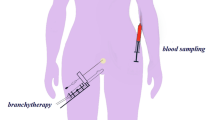Abstract
The segmentation of patient data often is mandatory for surgical simulations to enable realistic visual and haptic rendering. The necessary preparation time lies in the range from several hours to days. Here we augment a direct haptic volume rendering approach for lumbar punctures by edge-preserving smoothing preprocessing. Evaluation is carried out on user defined paths. Compared to our reference system force output can be improved over non-preprocessed image data.
Access this chapter
Tax calculation will be finalised at checkout
Purchases are for personal use only
Preview
Unable to display preview. Download preview PDF.
Similar content being viewed by others
References
Abolhassani N, Patel R, Moallem M. Needle insertion into soft tissue: a survey. Med Eng Phys. 2007;29(4):413–31.
Färber M, Hoeborn E, Dalek D, et al. Training and evaluation of lumbar punctures in a VR-environment using a 6DOF haptic device. Stud Health Technol Inform. 2008;132:112–4.
Färber M, Hummel F, Gerloff C, et al. Virtual reality simulator for the training of lumbar punctures. Methods Inform Med. 2009;48(5):493–501.
Mastmeyer A, Fortmeier D, Handels H. Direct Haptic Volume Rendering in Lumbar Puncture Simulation. In: Medicine Meets Virtual Reality 19; 2012.
Lundin K, Ynnerman A, Gudmundsson B. Proxy-based haptic feedback from volumetric density data. Eurohaptics Conference. 2002; p. 104–9.
Perona P, Malik J. Scale-space and edge detection using anisotropic diffusion. IEEE Trans Pattern Anal Mach Intell. 1990;12:629–39.
Author information
Authors and Affiliations
Corresponding author
Editor information
Editors and Affiliations
Rights and permissions
Copyright information
© 2012 Springer-Verlag Berlin Heidelberg
About this chapter
Cite this chapter
Mastmeyer, A., Fortmeier, D., Handels, H. (2012). Anisotropic Diffusion for Direct Haptic Volume Rendering in Lumbar Puncture Simulation. In: Tolxdorff, T., Deserno, T., Handels, H., Meinzer, HP. (eds) Bildverarbeitung für die Medizin 2012. Informatik aktuell. Springer, Berlin, Heidelberg. https://doi.org/10.1007/978-3-642-28502-8_50
Download citation
DOI: https://doi.org/10.1007/978-3-642-28502-8_50
Published:
Publisher Name: Springer, Berlin, Heidelberg
Print ISBN: 978-3-642-28501-1
Online ISBN: 978-3-642-28502-8
eBook Packages: Computer Science and Engineering (German Language)




